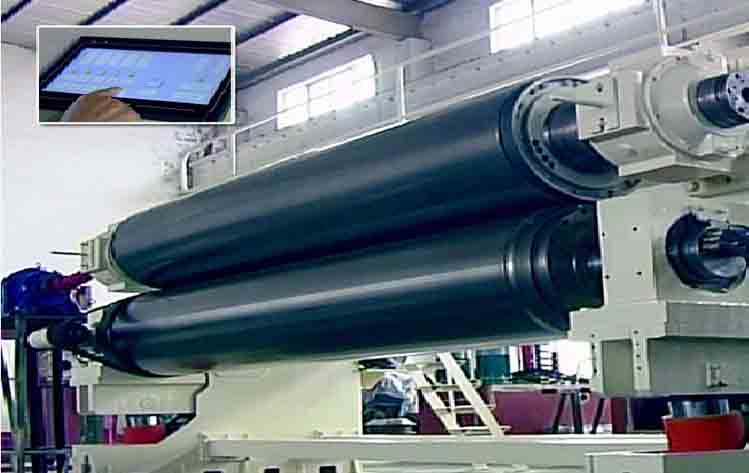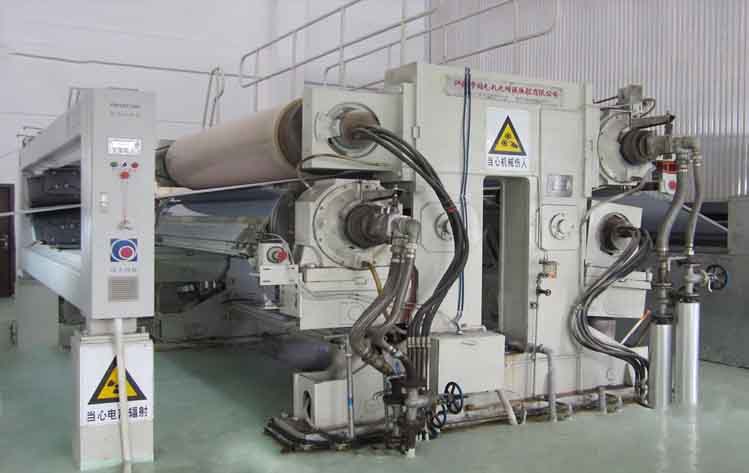Paper Calendar
Paper calendar is a kind of paper trimming equipment that is used to improve the gloss of paper, and it refers to the calendering process. After the surface of paper is coated, and then the glazing layer is dried, the calender can be used if the smoothness and gloss of the glazing layer are needed to be improved again. Generally, the gloss of the glazing layer is about 65-85%, and after calendered, it can reach a gloss of 90-95% or more.
In most of paper or cardboard making mills, the calendar is set in the position behind the drying section. When producing some specialty papers, a super calender is usually required. With the continuous improvement of the quality and output of paper or cardboard, gloss calender, soft roll calender or super soft calender should placed behind the drying section of the paper machine.
Calender plays several functions: one is trimming in order to improve the smoothness, gloss and tightness of the paper or to increase the smoothness and gloss while maintaining the bulkness, that is, the tightness is increased little. The second is to correct the thickness of the paper web, or to maintain relatively uniform tightness. The broken length of the calendered paper will increase the folding times.
Main influence factors of the calendering effect
The calendering quality of the paper web depends on various process factors before its calendering, such as the ratio of paper pulp, the beating degree and the moisture of paper web. It also depends on the operation and structural factors of the calender, such as system pressure, roll temperature and roll surface roughness, rolling area number, web moisture, time, and the like.
To achieve the trimming and thickness correction of the calender, different calendering methods can be used, that is, different combinations of line pressure, different number of rolls, and different roll temperatures. However, the used calendering method is limited under any particular equipment condition. When the calender is required to be used for trimming, it used to be realized by multiple rolling areas, but now it is realized by single rolling area and heating calender roll. Thus, with single rolling area or fewer areas, the calender has the possibility of reducing the number of rolls and the line pressure, saving cost and reducing the ratio of chemical pulp. It is required to use a method of locally heating or cooling the rolls when the thickness correction is done, and the effect is remarkable.
Classification
According to relative surface hardness of a pair of rolls in one rolling area:
- Hard rolling area:paper calendar, semi-dry calender, etc.
- Soft rolling area: gloss calender, super calender, soft roll calender, super soft calender, etc.
According to the installed positions:
- Paper calender is installed behind the drying section of the paper making machine or the board making machine.
- Semi-dry calender is installed inside the drying section of the paper making machine or board making machine.
- Super calender is installed outside the paper making machine or the coating machine.
- Gloss calender is installed behind the drying section of the coating station of the board coating machine.
- Soft roll calender is installed behind the drying section of the paper making machine or board making machine, but is also installed outside the machine.
- Super soft calender is installed behind the drying section of the coating station in the paper making machine or the coating machine.
Main components
Cold casting roll
The calender rolls are typically formed by integrally casting the roll body with the journal. When the width of the paper calender is more than 5000mm, the cold casting iron roll is used with press-fit steel journal. For the soft roll calender with large line pressure, or the top and bottom rollers of the super calender which is not controllable for medium and high rolls, the outer layer of the press-fit steel journal or full-length steel journal is a double-layered roll of cold casting iron. The body of the controllable medium and high roll is also made of cold casting iron.
Hot roll
Hot roll is used in the paper machine calender, super calender, soft roll calendar and super soft calender. It is a cold casting roll with the shaft with a small hole the steam or hot water passes through. However, the temperature distribution of the surface is very uneven, and the effect is not satisfactory. The medium for heating the roll surface is hot water or hot oil. The water or oil is heated by electric or steam outside the roll, and is pumped to finish the circulation. All the operations are carried out by automatic control system.
Pressure loading mechanism and pressure releasing mechanism
Pressure loading mechanism adopts the forms of heavy hammer lever or pneumatic lever and hydraulic lever. In the trimming calender (including super calender, super soft calender) for high-grade paper, pressure releasing mechanism and controllable medium and high bottom rolls are simultaneously adopted.
Frame
The calender frame should have sufficient rigidity, especially for super calender.
Scraper and safety bar
In order to prevent roll sticking, broken end’s wrapping roll. paper guiding and roll surface cleaning, each roll of paper calender is provided with the scraper at the outlet of the rolling area . At the inlet, each set of rolls, safety bars must be installed to prevent hands or foreign objects from entering the area, causing equipment damages and personal accidents. The safety bar is usually mounted in the bearing cast of calender roll.
Gloss calender
Gloss calender is a kind of soft calender, which is an important trimming equipment for coating cardboard and coating paper.
ZY calender is an ideal trimming equipment for improving paper quality in the paper making industry. The roll is made of the alloy cold casting. Its hardness is 70-76 degrees Shore.
ZY calender matched with the paper making machine with corresponding net paper width, the paper is mainly calendered to improve the smoothness, gloss and tightness, and the thickness of the paper is evenly uniform, improving the appearance and quality of the paper.
Main technical parameters


| Model | ZY18 | ZY21 | ZY24 | ZY26 | ZY28 | ZY32 | ZY34 | ZY36 | ZY44 |
| Roll Width (mm) | 2200 | 2400 | 2700 | 2900 | 3200 | 3500 | 3700 | 3900 | 4000 |
| Gauge (mm) | 3100 | 3300 | 3600 | 3800 | 4100 | 4400 | 4600 | 4800 | 5000 |
| Max. Line Pressure (N/mm) | 80 | ||||||||
| Pressurized Lifting Form | Pneumatic rubber film pressurized electric lifting | ||||||||
| Transmission Form | Total shaft drive | ||||||||
| Working Speed (m/min) | 350-500 |

